Nour Kouzayha
Unveiling Wireless Users' Locations via Modulation Classification-based Passive Attack
Feb 26, 2025



Abstract:The broadcast nature of the wireless medium and openness of wireless standards, e.g., 3GPP releases 16-20, invite adversaries to launch various active and passive attacks on cellular and other wireless networks. This work identifies one such loose end of wireless standards and presents a novel passive attack method enabling an eavesdropper (Eve) to localize a line of sight wireless user (Bob) who is communicating with a base station or WiFi access point (Alice). The proposed attack involves two phases. In the first phase, Eve performs modulation classification by intercepting the downlink channel between Alice and Bob. This enables Eve to utilize the publicly available modulation and coding scheme (MCS) tables to do pesudo-ranging, i.e., the Eve determines the ring within which Bob is located, which drastically reduces the search space. In the second phase, Eve sniffs the uplink channel, and employs multiple strategies to further refine Bob's location within the ring. Towards the end, we present our thoughts on how this attack can be extended to non-line-of-sight scenarios, and how this attack could act as a scaffolding to construct a malicious digital twin map.
Personalized Federated Learning for Cellular VR: Online Learning and Dynamic Caching
Jan 20, 2025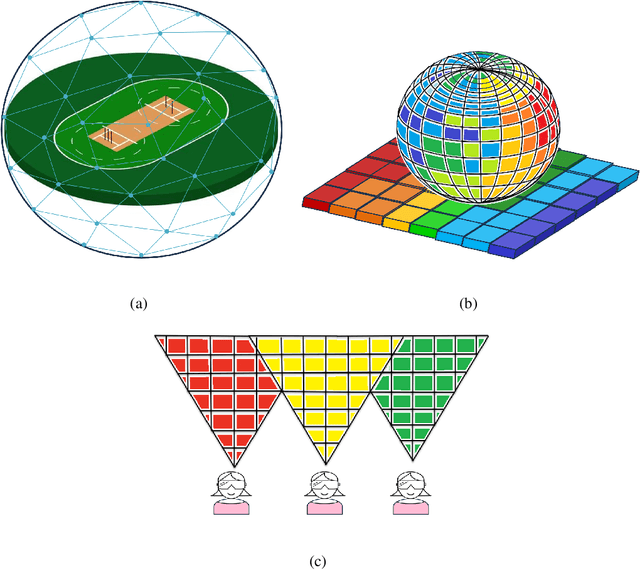
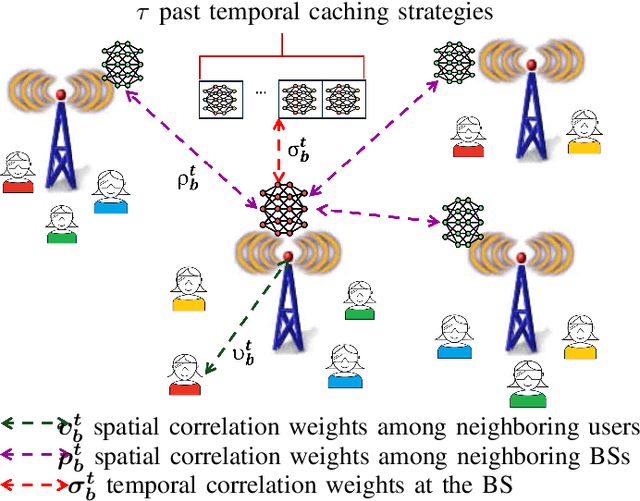


Abstract:Delivering an immersive experience to virtual reality (VR) users through wireless connectivity offers the freedom to engage from anywhere at any time. Nevertheless, it is challenging to ensure seamless wireless connectivity that delivers real-time and high-quality videos to the VR users. This paper proposes a field of view (FoV) aware caching for mobile edge computing (MEC)-enabled wireless VR network. In particular, the FoV of each VR user is cached/prefetched at the base stations (BSs) based on the caching strategies tailored to each BS. Specifically, decentralized and personalized federated learning (DP-FL) based caching strategies with guarantees are presented. Considering VR systems composed of multiple VR devices and BSs, a DP-FL caching algorithm is implemented at each BS to personalize content delivery for VR users. The utilized DP-FL algorithm guarantees a probably approximately correct (PAC) bound on the conditional average cache hit. Further, to reduce the cost of communicating gradients, one-bit quantization of the stochastic gradient descent (OBSGD) is proposed, and a convergence guarantee of $\mathcal{O}(1/\sqrt{T})$ is obtained for the proposed algorithm, where $T$ is the number of iterations. Additionally, to better account for the wireless channel dynamics, the FoVs are grouped into multicast or unicast groups based on the number of requesting VR users. The performance of the proposed DP-FL algorithm is validated through realistic VR head-tracking dataset, and the proposed algorithm is shown to have better performance in terms of average delay and cache hit as compared to baseline algorithms.
UAV-assisted Unbiased Hierarchical Federated Learning: Performance and Convergence Analysis
Jul 05, 2024Abstract:The development of the sixth generation (6G) of wireless networks is bound to streamline the transition of computation and learning towards the edge of the network. Hierarchical federated learning (HFL) becomes, therefore, a key paradigm to distribute learning across edge devices to reach global intelligence. In HFL, each edge device trains a local model using its respective data and transmits the updated model parameters to an edge server for local aggregation. The edge server, then, transmits the locally aggregated parameters to a central server for global model aggregation. The unreliability of communication channels at the edge and backhaul links, however, remains a bottleneck in assessing the true benefit of HFL-empowered systems. To this end, this paper proposes an unbiased HFL algorithm for unmanned aerial vehicle (UAV)-assisted wireless networks that counteracts the impact of unreliable channels by adjusting the update weights during local and global aggregations at UAVs and terrestrial base stations (BS), respectively. To best characterize the unreliability of the channels involved in HFL, we adopt tools from stochastic geometry to determine the success probabilities of the local and global model parameter transmissions. Accounting for such metrics in the proposed HFL algorithm aims at removing the bias towards devices with better channel conditions in the context of the considered UAV-assisted network.. The paper further examines the theoretical convergence guarantee of the proposed unbiased UAV-assisted HFL algorithm under adverse channel conditions. One of the developed approach's additional benefits is that it allows for optimizing and designing the system parameters, e.g., the number of UAVs and their corresponding heights. The paper results particularly highlight the effectiveness of the proposed unbiased HFL scheme as compared to conventional FL and HFL algorithms.
On the Interplay of Artificial Intelligence and Space-Air-Ground Integrated Networks: A Survey
Jan 20, 2024



Abstract:Space-Air-Ground Integrated Networks (SAGINs), which incorporate space and aerial networks with terrestrial wireless systems, are vital enablers of the emerging sixth-generation (6G) wireless networks. Besides bringing significant benefits to various applications and services, SAGINs are envisioned to extend high-speed broadband coverage to remote areas, such as small towns or mining sites, or areas where terrestrial infrastructure cannot reach, such as airplanes or maritime use cases. However, due to the limited power and storage resources, as well as other constraints introduced by the design of terrestrial networks, SAGINs must be intelligently configured and controlled to satisfy the envisioned requirements. Meanwhile, Artificial Intelligence (AI) is another critical enabler of 6G. Due to massive amounts of available data, AI has been leveraged to address pressing challenges of current and future wireless networks. By adding AI and facilitating the decision-making and prediction procedures, SAGINs can effectively adapt to their surrounding environment, thus enhancing the performance of various metrics. In this work, we aim to investigate the interplay of AI and SAGINs by providing a holistic overview of state-of-the-art research in AI-enabled SAGINs. Specifically, we present a comprehensive overview of some potential applications of AI in SAGINs. We also cover open issues in employing AI and detail the contributions of SAGINs in the development of AI. Finally, we highlight some limitations of the existing research works and outline potential future research directions.
Exploiting Hybrid Terrestrial/LEO Satellite Systems for Rural Connectivity
Nov 05, 2023Abstract:Satellite networks are playing an important role in realizing global seamless connectivity in beyond 5G and 6G wireless networks. In this paper, we develop a comprehensive analytical framework to assess the performance of hybrid terrestrial/satellite networks in providing rural connectivity. We assume that the terrestrial base stations are equipped with multiple-input-multiple-output (MIMO) technologies and that the user has the option to associate with a base station or a satellite to be served. Using tools from stochastic geometry, we derive tractable expressions for the coverage probability and average data rate and prove the accuracy of the derived expressions through Monte Carlo simulations. The obtained results capture the impact of the satellite constellation size, the terrestrial base station density, and the MIMO configuration parameters.
Time and Energy Constrained Large-Scale IoT Networks: The Feedback Dilemma
Apr 09, 2023



Abstract:Closed-loop rate adaptation and error-control depends on the availability of feedback, which is necessary to maintain efficient and reliable wireless links. In the 6G era, many Internet of Things (IoT) devices may not be able to support feedback transmissions due to stringent energy constraints. This calls for new transmission techniques and design paradigms to maintain reliability in feedback-free IoT networks. In this context, this paper proposes a novel open-loop rate adaptation (OLRA) scheme for reliable feedback-free IoT networks. In particular, large packets are fragmented to operate at a reliable transmission rate. Furthermore, transmission of each fragment is repeated several times to improve the probability of successful delivery. Using tools from stochastic geometry and queueing theory, we develop a novel spatiotemporal framework to determine the number of fragments and repetitions needed to optimize the network performance in terms of transmission reliability and latency. To this end, the proposed OLRA is bench-marked against conventional closed-loop rate adaptation (CLRA) to highlight the impact of feedback in large-scale IoT networks. The obtained results concretely quantify the energy saving of the proposed feedback-free OLRA scheme at the cost of transmission reliability reduction and latency increment.
On the Downlink Coverage Performance of RIS-Assisted THz Networks
Feb 05, 2023

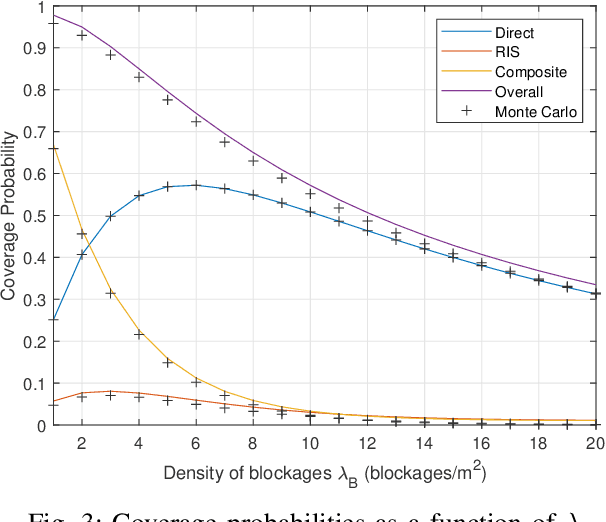

Abstract:This letter provides a stochastic geometry (SG)-based coverage probability (CP) analysis of an indoor terahertz (THz) downlink assisted by a single reconfigurable intelligent surface (RIS) panel. Specifically, multiple access points (AP) deployed on the ceiling of a hall (each equipped with multiple antennas) need to serve multiple user equipment (UE) nodes. Due to presence of blockages, a typical UE may either get served via a direct link, the RIS, or both links (the composite link). The locations of the APs and blockages are modelled as a Poisson point process (PPP) and SG framework is utilized to compute the CP, at a reference UE for all the three scenarios. Monte-Carlo simulation results validate our theoretical analysis.
Characterization of the Global Bias Problem in Aerial Federated Learning
Dec 29, 2022Abstract:Unmanned aerial vehicles (UAVs) mobility enables flexible and customized federated learning (FL) at the network edge. However, the underlying uncertainties in the aerial-terrestrial wireless channel may lead to a biased FL model. In particular, the distribution of the global model and the aggregation of the local updates within the FL learning rounds at the UAVs are governed by the reliability of the wireless channel. This creates an undesirable bias towards the training data of ground devices with better channel conditions, and vice versa. This paper characterizes the global bias problem of aerial FL in large-scale UAV networks. To this end, the paper proposes a channel-aware distribution and aggregation scheme to enforce equal contribution from all devices in the FL training as a means to resolve the global bias problem. We demonstrate the convergence of the proposed method by experimenting with the MNIST dataset and show its superiority compared to existing methods. The obtained results enable system parameter tuning to relieve the impact of the aerial channel deficiency on the FL convergence rate.
Towards Sustainable Internet of Underwater Things: UAV-aided Energy Efficient Wake-up Solutions
Aug 25, 2022

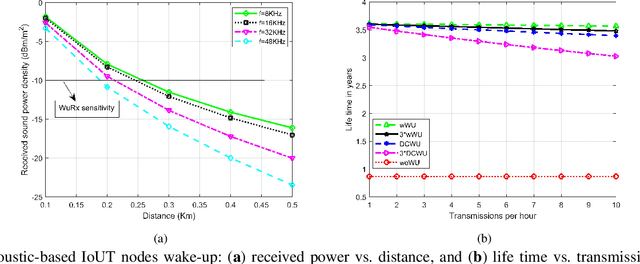
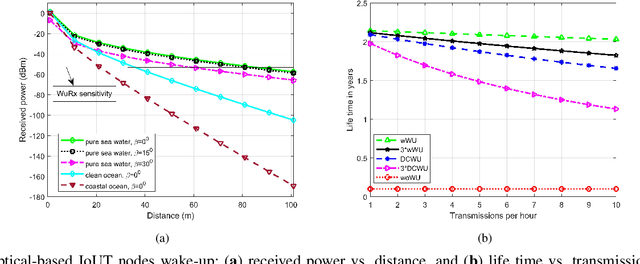
Abstract:With the advancements in underwater wireless communications, internet of underwater things (IoUT) realization is inevitable to enable many practical applications, such as exploring ocean resources, ocean monitoring, underwater navigation, and surveillance. The IoUT network comprises battery-operated sensor nodes, and replacing or charging such batteries is challenging due to the harsh ocean environment. Hence, an energy-efficient IoUT network development becomes vital to improve the network lifetime. Therefore, this paper proposes unmanned aerial vehicle (UAV)-aided energy-efficient wake-up designs to activate the underwater IoT nodes on-demand and reduce their energy consumption. Specifically, the UAV communicates with water surface nodes, i.e., buoys, to send wake-up signals to activate the IoUT sensor nodes from sleep mode. We present three different technologies to enable underwater wake-up: acoustic, optical, and magnetic induction-based solutions. Moreover, we verify the significance of each technology through simulations using the performance metrics of received power and lifetime. Also, the results of the proposed on-demand wake-up approach are compared to conventional duty cycling, showing the superior performance of the proposed schemes. Finally, we present some exciting research challenges and future directions.
Terahertz-Band Non-Orthogonal Multiple Access: System- and Link-Level Considerations
Nov 02, 2021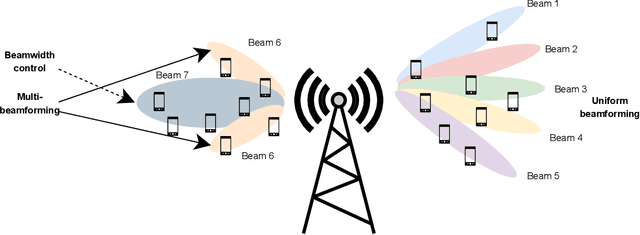
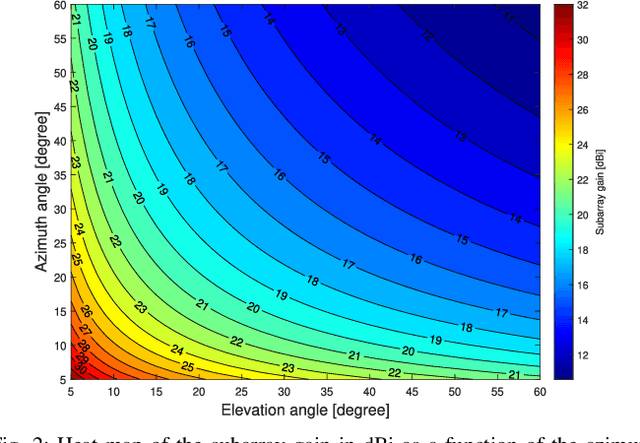
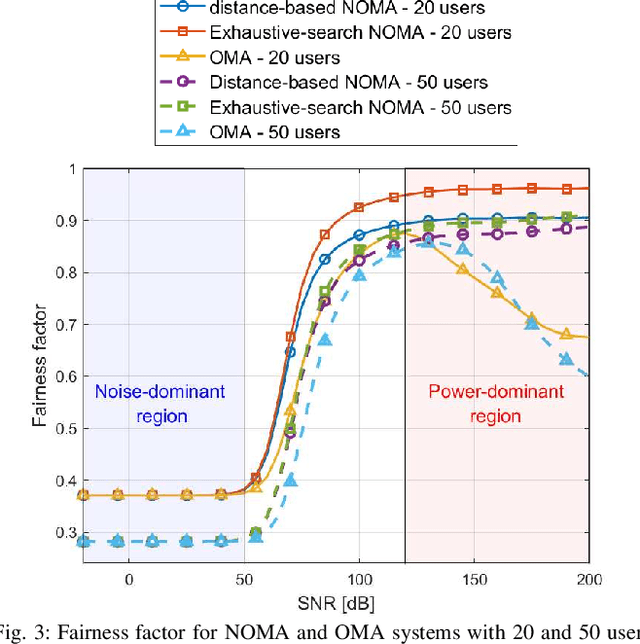
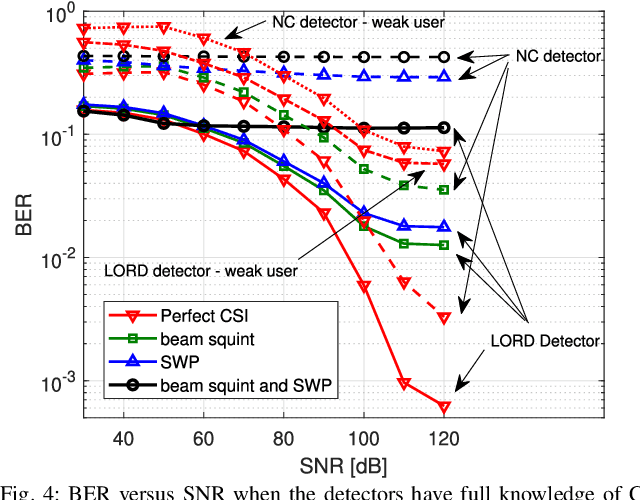
Abstract:Non-orthogonal multiple access (NOMA) communications promise high spectral efficiency and massive connectivity, serving multiple users over the same time-frequency-code resources. Higher data rates and massive connectivity are also achieved by leveraging wider bandwidths at higher frequencies, especially in the terahertz (THz) band. This work investigates the prospects and challenges of combining these algorithmic and spectrum enablers in THz-band NOMA communications. We consider power-domain NOMA coupled with successive interference cancellation at the receiver, focusing on multiple-input multiple-output (MIMO) systems as antenna arrays are crucial for THz communications. On the system level, we study the scalability of THz-NOMA beamforming, clustering, and spectrum/power allocation algorithms and motivate stochastic geometry techniques for performance analysis and system modeling. On the link level, we highlight the challenges in channel estimation and data detection and the constraints on computational complexity. We further illustrate future research directions. When properly configured and given sufficient densification, THz-band NOMA communications can significantly improve the performance and capacity of future wireless networks.
 Add to Chrome
Add to Chrome Add to Firefox
Add to Firefox Add to Edge
Add to Edge